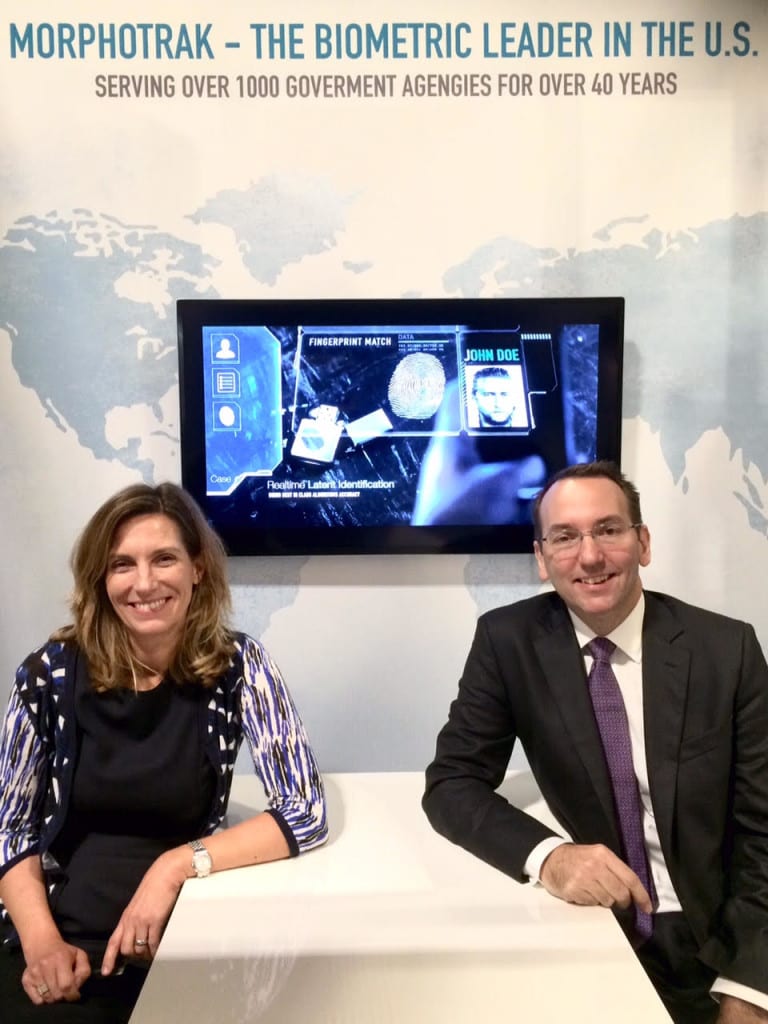Interview with Celeste Thomasson, President and CEO and Steve Vinsik, Vice President & General Manager, Criminal Justice and Public Security, MorphoTrak
 Recently, FindBiometrics president Peter O’Neill had the opportunity to speak with Celeste Thomasson, President and CEO of MorphoTrak (Safran), as well as Steve Vinsik, the company’s Vice President & General Manager of Criminal Justice and Public Security. The conversation begins with a discussion of Thomasson’s recent Women in Biometric Identity Award from Secure ID News and the leadership philosophy she brings to MorphoTrak, having been appointed to the leading position in 2014. Vinsik joins the conversation to talk about the newly released Morpho Video Investigator and new innovations in the company’s pipeline. Both experts also weigh in on privacy and education in an industry that is finally hitting the mainstream.
Recently, FindBiometrics president Peter O’Neill had the opportunity to speak with Celeste Thomasson, President and CEO of MorphoTrak (Safran), as well as Steve Vinsik, the company’s Vice President & General Manager of Criminal Justice and Public Security. The conversation begins with a discussion of Thomasson’s recent Women in Biometric Identity Award from Secure ID News and the leadership philosophy she brings to MorphoTrak, having been appointed to the leading position in 2014. Vinsik joins the conversation to talk about the newly released Morpho Video Investigator and new innovations in the company’s pipeline. Both experts also weigh in on privacy and education in an industry that is finally hitting the mainstream.

Peter O’Neill, President, FindBiometrics (FB): Congratulations, Celeste, on winning the inaugural Women in Biometric Identity Award from our friends over at SecureIDNews. It was a wonderful initiative on their part. Please tell us about this.
Celeste Thomasson, MorphoTrak (CT): Well, I am very honored to be selected for the award and moreover to have shared that with four other women who have played a significant and influential role in the industry. I became involved in the biometrics industry in the mid-2000’s, during the acquisition of L1 Identity Solutions, the largest acquisition in the industry which Safran accomplished in the 2010/11 timeframe. It gave me the opportunity to gain deep insight into the technology, marketplace dynamics and customer missions. I am very pleased to have the opportunity to stay engaged with the industry by assuming the CEO & President position at MorphoTrak, a 40+ year old company serving 1,000 government agencies and end users across the US.
FB: We reported back in January 2014, as you were just mentioning, of your appointment as President and CEO of the company. Leadership in a rapidly growing industry like ours is always a challenge; can you briefly describe your leadership philosophy for the company?
CT: I would say, “empowerment and engagement.” To sustain our leadership position in a dynamic and highly competitive market, it is important that we stay agile as an organization so we can adapt to industry changes more rapidly and better serve our customers. To do this, we focus on developing our competence and knowledge via key talent recruitment and professional development. We have been hiring some of the best biometric subject matter experts in the industry, bringing them on board. We have a relatively flat organizational structure, as it is intended to empower our experts to bring the voice of the customers and market insights into our company, and help us drive our company roadmaps. Empowerment and engagement will enable us to stay competitive and bring the best solutions to our customers.
FB: With MorphoTrak under your leadership what have been the highlight moments for the company so far? I know, for example, that you released a new product at the Global Identity Summit called Morpho Video Investigator, a video analytic software solution. Can you perhaps tell us about it?
CT: I think Steve should talk about that because he and his team have been instrumental in driving the requirements for the Morpho Video Investigator development.
Steve Vinsik, MorphoTrak (SV): I think this builds off of the last question about the team that we are bringing to MorphoTrak. Morpho Video Investigator (MVI) is certainly driven by customer needs and having the right people in place to help us develop this innovative solution around video analytics. So with Morpho Video Investigator, we listened to our customers and found out what they needed from a product and from the capability. This is going back a couple of years ago to the Boston Marathon bombing where there was a huge amount of video that the FBI had to analyze very quickly to try to identify suspects. The capabilities that we developed into the MVI product allow law enforcement agencies at the state, local, and federal levels to very quickly look at large amounts of data and get actionable intelligence that they can then use to solve crimes.
FB: That is a critical area these days with so much information out there. How does one control the privacy aspect of that?
SV: There are a lot of concerns around privacy and you can look at it from a couple of different perspectives. Privacy must be part one of key parameters in solution design. Assessment must be done to ensure that the technology is applied and used in a lawful manner. When we start analyzing video data to get actionable intelligence and identify people, a framework must be in place. There is still, I think, in the law enforcement community some work that needs to be done to make sure that data is protected and it is only used for investigation purposes. These are tools to support investigation, and not for true identification, for example. Most of the use cases today are for investigative leads that law enforcement agencies can then use to find additional information to make that positive identification of a suspect. MVI’s main purpose is to leverage video analytics to automate the processing of raw video data and help shorten the investigation time. In post- event investigations, every second counts in finding information and solving cases.
FB: Every year FindBiometrics does a Year in Review survey and one of the questions we ask is, what are the biggest challenges affecting our industry? Over the years these answers have changed. It used to be all about interoperability and standards, but over the past five years privacy and educating the public about technology have consistently ranked as the biggest challenges we as an industry face. As a leader in the industry what are your views of how we can overcome these challenges? We talked a little bit about privacy, what do we do about the education part?
CT: We think that the industry has to act together. Clearly we can’t do it alone as MorphoTrak and so we are very actively involved in the major trade associations: IBIA, SIBA, IJIS and SIA for examples. Through those groups we are helping to shape our industry messages and help educate the public about the benefits of biometric technologies.
SV: I think also from a mobility perspective, that companies like Apple and Google and others offering biometrics on consumer smartphones have accelerated the mainstream adoption of the technology. People are becoming more comfortable with the use of biometrics. It does certainly bring up the privacy concerns – absolutely – around what happens with their biometric data; how is it stored, how is it managed, what happens if somebody obtains it. As a responsible technology leader, we have to look at all those issues carefully. It is why being a part of these industry associations is not an option but a key part of our market engagement strategies, having a clear message that we do take privacy and data security very seriously.
FB: You know, it is really interesting that you mentioned Apple. I remember two years ago when the Touch ID announcement was made and how it has changed our industry ever since. It was remarkable. Overnight, biometrics became a cool thing as opposed to a negative thing. Mobility certainly is a hot area today for biometrics. Are you excited about the advances and some of the challenges in this area?
SV: I came to MorphoTrak a little bit more than a year ago and there are two reasons why I came to MorphoTrak. One is the technology. There are so many exciting things that we are doing; the MorphoWave technology, the contactless capability to identify fingerprints without having to put your fingers down on an optical reader for example. The way it is advancing in the industry is tremendous. The ability to do contactless capture of fingerprints from a smartphone camera is another application that we offer. These are just some of the advances we have on our roadmap. We strive as a company to pair the technologies and our customers’ missions together. The second reason is that MorphoTrak is a very mission-focused company. Our minds are always on what is going to make the job easier for law enforcement officers out in the field and having this enabling technology that is easy to use, that doesn’t require them to have extra devices to hold on to but having a contactless way to capture fingerprints, for example, is something that we think is very powerful and provides safety and operational values.
FB: I had an opportunity, at ISC West this past April, to try out your MorphoWave system and it is remarkable how quickly it works.
SV: It is, and there has been a lot of research by some of the best researchers that we have in the industry from our parent company Morpho in France. Most recently we’ve worked very closely with NIST, MITRE and the FBI to help look through different ways of standardizing this technology, because we are not only bringing a Morpho technology to market, but we want the industry and user communities as a whole to adopt this type of technology. We are convinced this is the future for the collecting of fingerprint biometrics out in the field. Having other stakeholders and companies to take part of the standardization process will significantly help with speeding up the adoption of contactless fingerprint capture.
FB: You certainly both have your hands full and I understand you just opened a new office in West Virginia, is this correct?
CT: Yes, we are in the process of doing that. We have hired a very talented team in West Virginia and we are in the process of getting our office space fitted out and projecting an opening in the fourth quarter.
FB: Well congratulations again on the award and I look forward to getting our next update from you. Thanks for speaking with FindBiometrics today.
CT & SV: Thank you Peter. It is our pleasure.


Follow Us